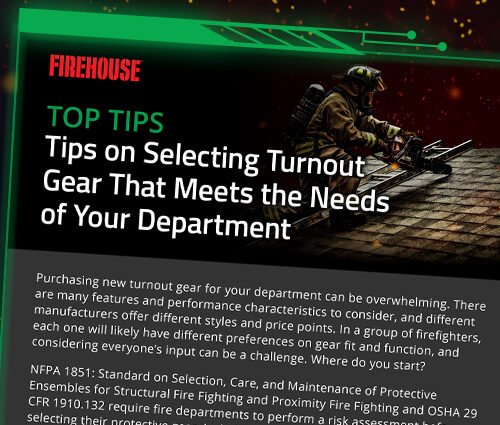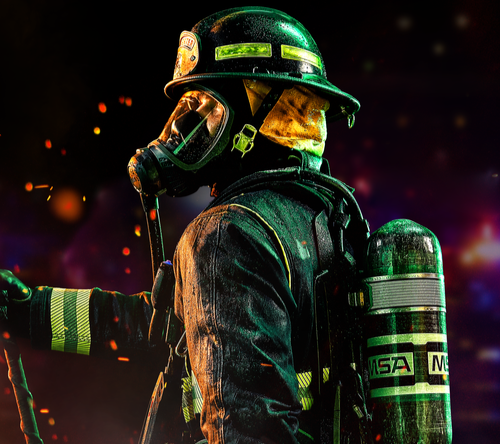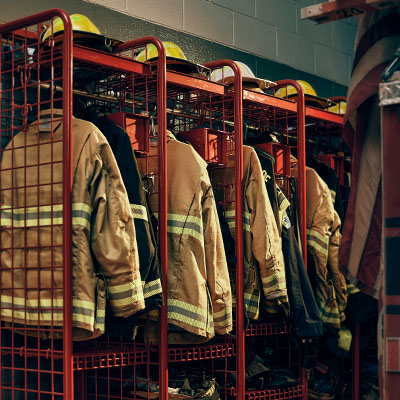
Over the past several years, we have written various columns associated with the care and maintenance of firefighter protective clothing and equipment. One of the perennial issues on this topic has been gear service life. In many cases, this particular topic has been a subject of polarization among the fire service, particularly when it comes to firefighter helmets. In this month’s column, we attempt to shed more light on this topic to allow fire departments and individual firefighters to make better informed choices with respect to their gear service life.
All clothing and equipment have a finite service life. For the most part, turnout gear is designed to be quite durable, made with rugged materials that are intended to repeatedly provide protection under a wide range of varying exposure conditions. By definition, service life is the length of time that clothing and equipment can remain in service while still providing a minimum level of protection. Nevertheless, even brand new gear that is subject to a serious fire event can require immediate retirement. Similarly, gear that is abused or improperly cared for can also lead to a shortened service life.
The interpretation of service life will further depend on an individual organization’s understanding of what factors constitute continued safe usability of clothing and equipment, which can also be influenced by available resources. Yet, since 2008, NFPA 1851: Selection, Care and Maintenance of Structural Firefighting Protective Clothing has imposed a 10-year service life limit based on the element manufacturing date for any structural firefighting ensemble element, including garments, helmets, gloves, footwear and hoods.
The reality of turnout gear service life
Every five years, the NFPA conducts an extensive needs assessment of the fire service. This assessment entails getting answers and information in response to a comprehensive set of questions and inquiries directed to fire departments across the United States. The content covers key issues regarding equipment, operations, training, safety and health issues. Among the areas of inquiry are certain questions related to personal protective equipment (PPE).
According to the information obtained from the most recent NFPA needs assessment published in 2016, 71.7 percent of the departments indicated they had at least some protective clothing at least 10 years old – meaning that the use of this gear would not comply with NFPA 1851. The NFPA further breaks down these statistics by the size of the jurisdiction served by the department, which shows departments over smaller populous areas having larger proportions of older gear with no real shift in the trend over the four needs assessments conducted in 2001, 2005, 2010 and 2015.
A survey of the fire service conducted by the Fire Protection Research Foundation in 2013 further examined care and service issues for firefighter protective clothing. This survey expanded on some of the earlier NFPA needs assessment questions, including determining how long departments were keeping gear in service. Not unsurprisingly, many survey participants reported that gear was generally retired between seven and 10 years of use, but there was an equal number of respondents indicating that gear was not retired until after 10 years of service. Information was provided by individual element – coats, pants, hoods, helmets, gloves and footwear – and the numbers showed that helmets tended to be kept in service the longest.
The primary reasons for continued use of older gear usually boils down to available resources and the relative wear and tear on gear in use. According to the same needs assessment, some fire departments struggle with providing all of their firefighters with full gear. Many departments are unable to provide second sets of gear or regular cleanings. The situation also occurs where departments do not have many structural fires which allows them to extend the life of their gear simply because it does not have the wear and tear that causes any breakdown of performance.
However, there are also circumstances where gear is kept in service well beyond its use, even if worn out and with signs of degradation, which can affect overall protection. Lastly, some firefighters want to keep their gear because of its personal value – a sign of their experience or a preference for old items as compared to newer products available in the marketplace.
The appropriate basis for service life
A common question asked by many in the fire service is “Why did the committee responsible for NFPA 1851 decide to include a requirement for a maximum 10-year service life?” Contrary to the belief of some, it was not because of a conspiracy by manufacturers to sell more gear.
The basic logic that was used was based on a combination of product obsolescence and experience. NFPA standards are generally revised every five years and each new edition of the standard bring changes in response to fire service needs and experience for improvements in their gear. Many of these changes can be minor, but, over the years, they add up.
For example, drag rescue devices are a relatively new feature of protective coats that would not be found in some coats over 10 years old. Moreover, many performance requirements have been updated in response to identified improvements made in protection offered by ensemble elements. Therefore, 10 years represents two cycles of revision so that products can be kept up to date to the latest safety standards. This is not an uncommon practice where newer products are considered safer and more consistent in their performance.
Secondly, there is a vast amount of experience and research to suggest that used gear, even when properly maintained, will eventually wear out. Gear manufacturers and material or component suppliers have monitored the performance of their products in the field and over time, and have found that the combination of physical or thermal exposures, combined with ordinary wear and tear, does lead to breakdown of clothing and equipment. In many cases components can be repaired or replaced, such as a helmet faceshield that becomes heat damaged, but eventually there comes a point at which the number of repairs warrants full replacement of the gear item. Performance properties of clothing items have been tested at various stages during their service life, with some indicating degradation minimum requirements and others remaining relatively unchanged. All in all, turnout gear service life tends to become a judgement call when left to individuals.
The difficulty that arises with determining the continued serviceability of firefighter clothing or equipment is having the evidence at hand to make an informed decision. In reality, most performance properties on which the qualification of the item is based cannot be performed in the field or without destructive testing. Unless there is obvious damage, such as significant charring of an item, a physical breach or the item was subjected to a known consequential incident that brings its future into question, the fire service is confronted with having to make best guesses for gear serviceability. This is part of the reason NFPA 1851 does set a standard 10-year maximum service life for turnout gear.
Moving forward and understanding new trends in turnout gear service life
Until new, nondestructive test methods are made available that allow definitive determinations for gear viability, judgment will always be part of the decision for continued clothing and equipment serviceability. Yet, there are new reasons emerging that are likely to influence retirement decisions. Concerns over clothing and equipment contamination with the increase in cleaning options are likely to add factors that may subtract from gear longevity, rather than extend it. Right now, there are mixed opinions for how well gear will hold up to more frequent launderings. Other items, such as hoods, gloves and footwear, have been cleaned more often, while helmet suspension and ear covers are rarely cleaned. The impact of contamination control practices will certainly make a difference on busier departments and how they view turnout gear service life.
The question of service life is not going to be answered in the immediate future. As with all important matters, there is continuing research on this topic. The CDC is preparing to launch a multi-year project: “Evidence to Inform Standards that Ensure Turnout Gear Remains Protective Throughout its Lifecycle.” The CDC had previously invited the public to comment on the project and plans to provide for future public input.
The most important takeaway is that firefighter protective clothing and equipment must in be a serviceable condition in order for these items to provide the needed protection. When there are doubts, the prudent course of action is to reevaluate the gear and seek expertise for making the best possible decisions for continued use. In the meantime, firefighters will rely on checklists in NFPA 1851 and recommendations from suppliers for judging serviceability. And, while not always popular, the 10-year rule can be regarded as a safeguard for at least keeping up with new technology and perhaps lowering the risk for unseen degradation that takes place until better means of assessment become available.







